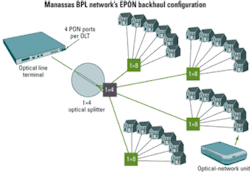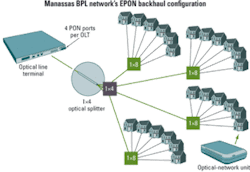Virginia municipal integrates EPON, BPL
Located 30 miles southwest of Washington, DC, the city of Manassas, VA, has recently garnered attention for its commercial deployment of broadband powerline (BPL) network technology. To access broadband Internet services, residents in many areas of the city have the option of plugging a modem into an electrical outlet to receive broadband Internet access with speeds comparable to DSL-based services. While subscriber bandwidth is ultimately delivered through the public utility’s electric power lines, a citywide EPON system was deployed to enable the HFBPL (hybrid fiber BPL) network with expansive fiber-optic backhaul capabilities.
Manassas owns and operates the network’s EPON component, which was provided by Alcoa’s AFL Telecommunications (Spartanburg, SC), a subsidiary of Fujikura Electric (Tokyo). The EPON system consists of optical line terminals (OLTs) connected to 1×4 optical splitters, which in turn feed a multipoint array of optical-network units (ONUs), which act as 1×8 fiber “modems.” The network’s BPL equipment, from Main.net Communications (Rosh Ha’ayin, Israel), is owned and operated by COMTek (Chantilly, VA), a third-party ISP.
“Basically, the municipal has an ONU out there which is really performing, in this case, just a media-converter function,” explains AFL Telecommunications business development engineer Guy Swindell. “The EPON product that’s being used was developed around the Japanese business model, so the ONU, or the subscriber side device, looks like a cable or DSL modem on steroids; it’s just a single fiber input and a 10/100 Ethernet output. That’s all you need to hand off to the BPL-there’s no need for void telephone adapters or multiple Ethernet outputs at this BPL handoff location.”
Swindell adds that the EPON system’s compactness also made it attractive to the municipality, since the subscriber side units were able to easily fit inside the utility’s existing transformer boxes. “The reason for EPON is pretty simple,” he notes. “The BPL technology being used here is an Ethernet-based Layer 2 platform. The EPON is also an Ethernet-based Layer 2 platform. So basically they mated together really well. You have a native Ethernet platform serving as a backhaul for another native Ethernet platform.”
A major precursor to the fiber-optic backhaul project was that Manassas had previously installed more than 60 miles of fiber infrastructure to enable future communications among its municipal government facilities as well as for eventual monitoring of its electric substations and water facilities. “We were already staffed with individuals that understood how to construct the fiber system,” explains Manassas utilities director John Hewa. “We had splicers, splice trailers, all the equipment. We really expanded upon that existing network in order to support the BPL system.”“They recognized early on that, as is common wisdom in the fiber industry, if you’re going to put in fiber, you may as well put in a bunch, because most of your cost is in the labor, and not in the glass,” remarks Walt Adams, vice president of COMtek’s commercial division. “As they were moving their utility conduits from overhead to underground-because they’re 82% underground in Manassas-they figured if they were going to lay in underground conduit for electrical, they were going to put in multiple conduits for future telecommunications use. Even though they didn’t necessarily have the application in place, they knew they would have a need for it in the future. That served as a wonderful foundation for putting in a BPL network.”
For deployment, the city, with an electric grid of 10.2 sq mi hosting nearly 2,000 transformers, reached a joint agreement with COMtek for a network design composed of 178 injection points connecting the fiber infrastructure to the BPL equipment. “It could have been done with a little less density than that,” notes Adams. “But because of the particular characteristics of Manassas-i.e., the willingness of the utility and the availability of fiber-we probably overbuilt the fiber connections a little bit, because we could.”
Hewa says “most of the fiber that was put in before BPL was point-to-point type connectivity using media converters and other types of standalone electronics-not part of an integrated system.” The city’s goal, according to Hewa, was to discern “the most economical way to get an Ethernet-based connection out to numerous points, spread out more or less throughout the city.” In light of this goal, Hewa says the municipality was particularly attracted to the AFL EPON system’s standalone features. “Because we install and own and maintain the fiber-optics of the system,” he explains, “we wanted a system that would provide end services on its own, independent of the BPL network.”
“This is probably the biggest emphasis point for Manassas,” adds AFL’s Swindell. “At the end of the day, despite all of the ‘gee whiz’ elements of PON, it really came down to the point-to-multipoint capability in this existing fiber plant.”
Adams says the HFBPL network’s design essentially employs three optical concentrators, each located at a different substation. A fiber trunk from a headend facility extends to each of these concentrators; four fibers from each concentrator then extend out to the residentially located BPL equipment. “We have multiple splice points per fiber, which is really the beauty of the EPON solution,” Adams believes. “We can do multiple taps and still have a high grade of service.”
Hewa emphasizes that because the EPON system’s subscriber side was composed of AC-powered devices and because the utility already needed to buy enclosures to contain the BPL devices, “we were able to simply marry the two together and collocate them in the same enclosure with the same power supply. All we really needed out of it was the Ethernet port, because we knew that this would be an IP-based Ethernet-based network and that BPL would be for the most part the push into all the homes and businesses.”
AFL/Fujikura’s EPON platform is a proprietary Ethernet PON platform, “standards-based to the extent that it’s the same 1×32 PON architecture that you would see with any PON,” offers Swindell. While not fully compliant with the 802.3ah PON standard, the platform, Swindell says, has been used extensively in Japan, deployed in FTTX architectures. “This particular EPON platform,” he continues, “has a pretty good bit of dynamic range. It’s got a pretty heavy-duty loss budget on it, and that proved to be pretty important [in Manassas]. Since this was an older legacy utility network, they had all sorts of old connectors, old fiber management, high losses in some areas.”
Swindell believes most other PON platforms, such as BPON or GPON, have some “inherent reflectance sensitivity. Those would have required cutting out and replacing a lot of the fiber management in the network. This little [EPON] platform kind of powered right through all of that stuff-it minimized the amount of retrofitting they had to do to put the PON out there.”
BPL, like EPON, is a symmetrical bandwidth platform, providing equivalent rates of upstream and downstream bandwidth. “That was another reason why it was attractive to use EPON as a backhaul,” says Swindell, “as opposed to, say, BPON, which has 622 Mbits downstream, but only 155 upstream.” In a BPON scenario, Swindell points out that “even with this fairly low speed-generation one BPL gear-the PON would’ve become the bottleneck at the upstream data traffic.”
“One of the other reasons why the EPON was a great selection was that it doesn’t limit any of the future possibilities that one can imagine out there in terms of fiber to the home or video services or whatever,” contends Adams. “The BPL deployment was a cost-justified reason to further develop the fiber-optic network out into the neighborhoods of the city-maybe not to the curb but out to the street corner, certainly. I think EPON was thoughtfully chosen because it preserves all of the future options, depending on what future circumstances the city may have and/or COMTek may have.”
To that end, the utility, Hewa notes, is “really starting to look more at the applications side” of the HFBPL network. Extended applications on deck for the municipality include support for integrated traffic signals and automated distribution switching as well as surveillance and meter reading applications. “We’re finding that as we build the BPL network,” he says, “it’s very easy to tap on any point and provide access for these other applications which may be anywhere, really, in the city. That’s kind of our concentration at this point-as well as expanding the network on the commercial side to hook up commercial business accounts.”
“What’s really important about Manassas,” adds Swindell, “is that the technology enables the business model. They’ve got this collaborative business model between the ISP and the utility, so the game plan is to build a network that is as robust as you can build it, and will deliver as much bandwidth as you can deliver, at a price point that enables you to make that business model successful.” In Swindell’s view, the city’s HFBPL network “did a super job of that, because it allowed you to get a connection to the customer at a price point that allowed that ISP collaboration to work.”
At the same time, he says, the network design allowed for cost-effective establishment of a fiber backbone “to accomplish the economic development incentives that you hear so often as a justification for municipal broadband networks. That was really the game plan. You can get an Ethernet high-speed data connection in Manassas, VA, the same way that you can in Bristol, VA. But Manassas has got $400,000 invested in their network, whereas Bristol floated a bond for several million dollars.”

